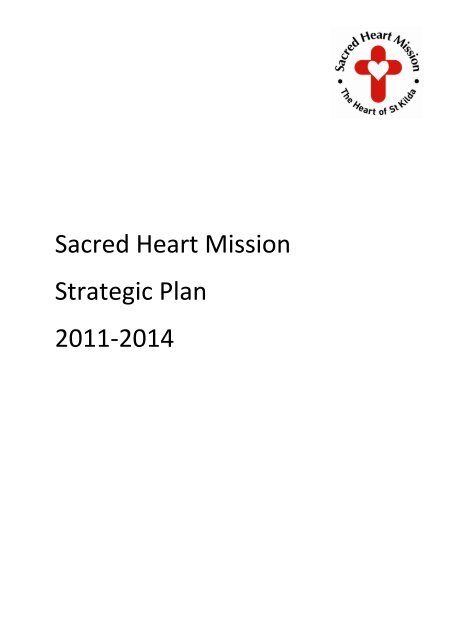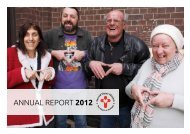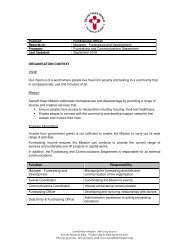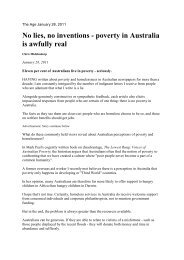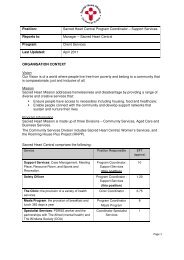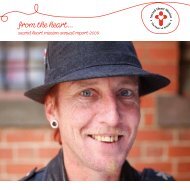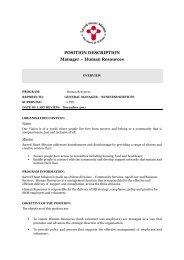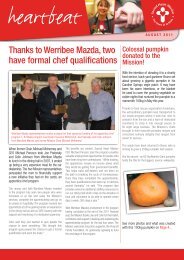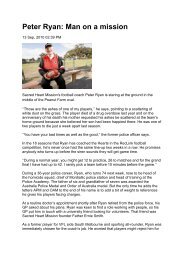The Strategic Plan - Sacred Heart Mission
The Strategic Plan - Sacred Heart Mission
The Strategic Plan - Sacred Heart Mission
Create successful ePaper yourself
Turn your PDF publications into a flip-book with our unique Google optimized e-Paper software.
<strong>Sacred</strong> <strong>Heart</strong> <strong>Mission</strong><br />
<strong>Strategic</strong> <strong>Plan</strong><br />
2011-2014
<strong>Sacred</strong> <strong>Heart</strong> <strong>Mission</strong> Inc<br />
87 Grey Street<br />
St Kilda, Vic, 3182<br />
PO Box 1284<br />
St Kilda South, Vic, 3182<br />
Telephone: 03 9537 1116<br />
Facsimile: 03 9525 3268<br />
Donations: 1800 443 278<br />
www.sacredheartmission.org<br />
ACN 62 843 874 179
Introduction<br />
<strong>Sacred</strong> <strong>Heart</strong> <strong>Mission</strong> (SHM) has a proud history of working with the most disadvantaged members<br />
of our community and assisting them to rebuild their lives.<br />
Every three years, SHM prepares a <strong>Strategic</strong> <strong>Plan</strong> that articulates the priorities for the planning<br />
period and focuses on building the capacity of the organisation to deliver sustainable outcomes for<br />
the people we work with.<br />
This <strong>Strategic</strong> <strong>Plan</strong>, covering 2011 – 2014, details an ambitious and exciting agenda. It builds on our<br />
existing expertise and consolidates our position as a best practice provider in delivering services to<br />
people who are homeless and have complex and challenging needs. <strong>The</strong> plan also has the potential<br />
to greatly enhance outcomes for the people experiencing chronic homelessness.<br />
We are confident that the energy, skills and commitment of our staff, volunteers and supporters will<br />
ensure the success of this plan.<br />
Process to Develop the <strong>Plan</strong><br />
Key stakeholder groups including staff, clients and residents, volunteers, parishioners, funders and<br />
other agencies had the opportunity to contribute in a meaningful way throughout this process and<br />
the plan is the result of a collaborative effort.<br />
Structure of the <strong>Plan</strong><br />
<strong>The</strong> plan identifies 3 Key Directions – Social Inclusion, Advocacy and Sustainability and Growth.<br />
<strong>The</strong>se Key Directions have been agreed as the main priorities for the organisation and each are<br />
supported by a set of goals and related objectives that will be implemented over the life of the plan.<br />
This <strong>Strategic</strong> <strong>Plan</strong> is supported by a Business <strong>Plan</strong> which identifies the person or team responsible<br />
for implementing each goal and its related objectives and the timeline for doing so. <strong>The</strong><br />
implementation of the Business <strong>Plan</strong> is monitored by SHM’s Board on a quarterly basis.<br />
Page | 1
Vision – <strong>Mission</strong> – Organisational Values<br />
<strong>Sacred</strong> <strong>Heart</strong> <strong>Mission</strong> has its origins in the welcoming response of the founder and parish priest, Fr<br />
Ernie Smith, to those who came knocking on the door of the Presbytery seeking food and shelter.<br />
In 1982, Fr Ernie gathered a small team of committed staff, who, with the support of the<br />
parishioners of St Kilda West, took up the Gospel call of Jesus Christ:<br />
‘for I was hungry and you gave me food; I was thirsty and you gave me drink; I was a<br />
stranger and you made me welcome; naked and you clothed me, sick and you visited<br />
me, in prison and you came to see me’ (Mt 25: verses 35-36).<br />
Since that time, the <strong>Mission</strong> has continued to respond to the basic needs of those who seek<br />
assistance. Progressively, it has sought to provide services which also address the underlying causes<br />
of disadvantage and help people to live life to the full.<br />
From its beginnings, the <strong>Mission</strong> has seen its work as living the story of Jesus’ life and teachings in<br />
today’s world. This work continues to be centred within the St Kilda area and is sustained by the<br />
deep pool of generosity and talent within the organisation and the broader community.<br />
<strong>Sacred</strong> <strong>Heart</strong> <strong>Mission</strong> is the Catholic Church in action and is supported by its strong relationship with<br />
the parishes of St Kilda West and Elwood.<br />
Vision<br />
Our Vision is of a world where people live free from poverty and belong to a community that is<br />
compassionate, just and inclusive of all.<br />
<strong>Mission</strong><br />
<strong>Sacred</strong> <strong>Heart</strong> <strong>Mission</strong> addresses homelessness and disadvantage by providing a range of diverse and<br />
creative services that:<br />
ensure people have access to necessities including housing, food and healthcare;<br />
enable people to connect with their community and develop support networks that<br />
sustain and nurture their lives.<br />
Values<br />
Welcome – we welcome and accept people as they are <strong>Sacred</strong> <strong>Heart</strong> <strong>Mission</strong> began with the<br />
opening of the Parish doors to whoever wished to come in. <strong>The</strong> spirit of the <strong>Mission</strong>’s work flows<br />
and develops from the notion of welcome, which it cherishes as integral to all it does.<br />
Community – we build community <strong>The</strong> <strong>Mission</strong> seeks to develop a sense of community amongst the<br />
people who use our service and establish connections with the broader community.<br />
Empowerment – we work with people to enable them to take control of their lives <strong>The</strong> dignity of<br />
the person means that each of us has the right to pursue our own path in life. We foster self worth<br />
as a means of empowering people.<br />
Challenge - we challenge the unjust structures of our society <strong>The</strong> <strong>Mission</strong> recognises that<br />
disadvantage is often created and perpetuated by unjust social and economic structures. We commit<br />
to identifying such structures, presenting fairer alternatives and advocating for change.<br />
Stewardship – We value our staff and volunteers and manage our resources effectively Staff and<br />
volunteers are highly valued and critical to the <strong>Mission</strong>’s work. <strong>The</strong> <strong>Mission</strong> also recognises its<br />
responsibility to effectively manage the resources entrusted to it by government, philanthropic<br />
organisations and donors.<br />
Page | 2
<strong>The</strong> <strong>Strategic</strong> <strong>Plan</strong>: Our Key Directions<br />
Key Direction 1: Social Inclusion<br />
<strong>Sacred</strong> <strong>Heart</strong> <strong>Mission</strong> believes that homelessness is one expression of social exclusion and that the<br />
solutions to it must be more comprehensive than if homelessness is seen solely as a lack of housing.<br />
Our social inclusion framework clearly articulates our understanding of social inclusion and the<br />
importance of embedding it in our daily work practices. Our experiences during 2007-2010 affirmed<br />
the importance of this strategic direction and we will continue to work towards consolidating and<br />
developing this approach to the work that we do by continuing to:<br />
Ensure our social inclusion framework is embedded in practice.<br />
Focus on measuring the outcomes of our work.<br />
Ensure the people who use our services have input into the way we operate and develop our<br />
services.<br />
Implement the Journey to Social Inclusion pilot program.<br />
Goal 1: Develop our expertise in supporting adults with complex needs and establish the<br />
organisation as a practice leader in this area<br />
SHM has been building a reputation for its practice expertise in supporting people who are homeless<br />
and socially excluded, particularly single adults with complex needs. Over the next three years SHM<br />
will build on this expertise in supporting people who are the most disadvantaged, consolidate our<br />
position as a best practice provider and further enhance outcomes for the people who use our<br />
services.<br />
Objectives<br />
1.1.1 Consolidate and build on our Social Inclusion Framework.<br />
1.1.2 Maximise the impact of the J2SI evaluation.<br />
1.1.3 Contribute to research.<br />
1.1.4 Develop partnerships with organisations who have expertise in supporting people who are<br />
chronically homeless and have complex needs.<br />
Page | 3
Key Direction 1: Social Inclusion (cont)<br />
Goal 2: Ensure our Aged Care operations meet the emerging needs of the <strong>Mission</strong><br />
community<br />
SHM is funded to provide 83 beds of residential aged care in St Kilda (<strong>Sacred</strong> <strong>Heart</strong> Community, Grey<br />
Street and Avonsleigh Terrace, Robe Street) and 75 Community Aged Care Packages (CACPS) through<br />
the Homecare program. SHM also has one position funded by the Assistance with Care and Housing<br />
for the Aged (ACHA) to assist clients over 55 years of age access appropriate services at SHM or in<br />
the community in general.<br />
A report on SHM’s Aged Care operations, SHM Aged Care Services: Developing our Aged Care<br />
Services to Meet the Needs of the Ageing Population (the “Report”), which was undertaken as part of<br />
the strategic planning process, identified four key issues:<br />
<strong>The</strong> need to improve the continuity of Care in our Residential Aged Care Facilities.<br />
Improving the financial viability of the Residential Aged Care Facilities.<br />
Potential Increased Demand for Concessional Aged Care Beds in the City of Port Phillip.<br />
Increased Care Needs of Homecare clients.<br />
Objectives<br />
1.2.1 Adopt a phased approach to increasing <strong>Sacred</strong> <strong>Heart</strong> <strong>Mission</strong>’s capacity to provide high<br />
care services at <strong>Sacred</strong> <strong>Heart</strong> Community (Grey Street).<br />
1.2.2 Assess the need to undertake a redevelopment of the Avonsleigh Terrace site.<br />
1.2.3 Review Homecare services and implement recommendations to ensure it is best placed to<br />
meet the increasing needs of clients.<br />
1.2.4 Develop partnerships with other aged care providers to ensure any demand SHM is unable<br />
to meet is met.<br />
Goal 3: Improve access to housing for people who use <strong>Mission</strong> services<br />
<strong>The</strong> outlook for the housing market suggests that housing affordability is going to continue to<br />
decline over the next three to four years. <strong>The</strong> gentrification of the City of Port Phillip and<br />
surrounding areas continues to increase the pressure on the private rental market which increasingly<br />
excludes people on low and middle incomes. In addition, despite considerable investment in social<br />
housing by both the Federal and State governments, demand for social housing outstrips supply. As<br />
affordable and appropriate housing is a key factor in ending homelessness, it is imperative that this<br />
plan includes strategies for improving access to housing for the people we work with.<br />
Objectives<br />
1.3.1 Establish a second supported housing facility.<br />
1.3.2 Develop stronger partnerships with housing providers to ensure SHM’s client group gets<br />
access to appropriate housing.<br />
Page | 4
Key Direction 1: Social Inclusion (cont)<br />
Goal 4: Implement a trauma informed approach to our service delivery<br />
Studies conducted in the US and Australia on the homeless population confirm high incidence rates<br />
of trauma compared to the general population with reports of more than one traumatic experience<br />
in the lifetime of the participants. According to one Australian study, adults experiencing<br />
homelessness are likely to have experienced on average six traumatic experiences, often starting in<br />
early childhood and commonly including physical and sexual assaults. 1<br />
It is well documented that people with unresolved trauma develop coping behaviours that are<br />
dysfunctional and can lead to difficulties in forming and maintaining relationships. This is particularly<br />
prevalent when the trauma occurs in early childhood and is prolonged.<br />
Given the evidence that people who are chronically homeless have usually experienced significant<br />
trauma and our understanding that this is likely to impact on their capacity to build and maintain<br />
relationships, SHM believes that service responses which aim to break the cycle of chronic<br />
homelessness must direct resources to identifying and resolving underlying trauma.<br />
Objectives<br />
1.4.1 Develop a trauma informed system of care.<br />
1.4.2 Contribute to research on trauma and homelessness.<br />
Goal 5: Improve connections to the community for the people we work with<br />
<strong>The</strong> importance of being connected within one’s community is well understood to be a key<br />
determinant of mental health and well-being. Our homes place us within a community and provide<br />
an anchoring point that allows us to get on with our lives. For people who are homeless, the sense<br />
of being socially included has been eroded. Further, people who are chronically homeless often face<br />
barriers that prevent their connection to community, such as a lack of independent living skills, poor<br />
interpersonal skills and entrenchment in the homeless sub culture.<br />
As part of the 2007- 2010 <strong>Strategic</strong> <strong>Plan</strong>, SHM introduced a social inclusion framework to guide its<br />
services and programs. While we have come a long way, our capacity to implement the social<br />
inclusion paradigm across all program areas has been limited by the resources available. This plan<br />
includes two initiatives that will strengthen our capacity to re-connect people to the community<br />
while addressing their other needs.<br />
Objectives<br />
1.5.1 Improve the coordination of social inclusion activities across <strong>Sacred</strong> <strong>Heart</strong> <strong>Mission</strong>.<br />
1.5.2 Implement an employment participation program.<br />
1 Understanding iterative homelessness: <strong>The</strong> case of people with mental disorders, Dr. C Robinson, Australian Housing and<br />
Urban Research Institute, Jul 2003<br />
Page | 5
Key Direction 2: Advocacy<br />
<strong>Sacred</strong> <strong>Heart</strong> <strong>Mission</strong> has identified three advocacy goals that will inform our communication with<br />
media, government, the sector and donors throughout the life of this plan.<br />
Goal 1: Improve housing affordability for people who use <strong>Mission</strong> services<br />
Accessing safe and affordable accommodation continues to be one of the key issues facing the<br />
people who use SHM’s services. While the Australian and Victorian Governments have taken a range<br />
of positive steps to address Australia’s housing affordability crisis over the last few years, these<br />
positive initiatives must be seen as first steps to be built upon.<br />
Serious attention must be directed towards increasing the supply of safe and affordable housing if<br />
we are to prevent an increase in homelessness.<br />
Objectives<br />
2.1.1 Promote increased investment in public and community housing.<br />
2.1.2 Promote using the tax system to improve housing affordability.<br />
Goal 2: Use the Journey to Social Inclusion implementation and evaluation to improve<br />
the service response to people who are chronically homeless<br />
<strong>The</strong> three year J2SI pilot began in November 2009 and involves 84 participants (40 who are receiving<br />
intensive support and a comparison group of 44 who are using the existing services that are<br />
available).<br />
<strong>The</strong> total cost over three years will be $4 million or $30,000 per supported participant per year plus<br />
establishment costs. This groundbreaking service delivery model focuses on addressing the<br />
underlying causes of a person’s homelessness and equipping them with the skills to reconnect to the<br />
mainstream community and build social networks outside of the homeless subculture.<br />
<strong>The</strong> purpose of undertaking J2SI is to demonstrate that a long term and intensive model can break<br />
the cycle of homelessness and the investment required is offset by the economic benefits generated<br />
from reduced service usage by participants and increased economic participation.<br />
Objectives<br />
2.2.1 Secure Government funding to undertake an extended pilot of J2SI.<br />
2.2.2 Share the lessons from J2SI with Government and the Community Sector in order to improve<br />
the way in which the service system interacts with people who are chronically homeless.<br />
Page | 6
Key Direction 2: Advocacy (cont)<br />
Goal 3: Improve the understanding of homelessness in the community, particularly at a<br />
local level<br />
It is important that the City of Port Phillip remains inclusive of all people, including those who are<br />
disadvantaged, so the people who use SHM services can connect with their local community and<br />
rebuild their lives. Inclusiveness is also an important factor in preventing community opposition to<br />
increased social housing in the region.<br />
Objectives<br />
2.3.1 Develop a community education project in relation to homelessness.<br />
2.3.2 Develop a position statement on street sex work.<br />
Page | 7
Key Direction 3: Sustainability and Growth<br />
<strong>Sacred</strong> <strong>Heart</strong> <strong>Mission</strong> recognises the importance of maintaining the organisation’s sustainability in<br />
order to ensure continuity of service provision for the people who use our services. Furthermore,<br />
the <strong>Mission</strong> is committed to exploring opportunities to grow the organisation in areas that are<br />
consistent with our Vision, <strong>Mission</strong> and Values and enhance our ability to support people who are<br />
chronically homeless and have a range of complex needs. To ensure sustainability and growth we<br />
will continue to:<br />
Maintain a strong relationship with the Parish of Elwood and St Kilda.<br />
Ensure strong financial management and financial controls.<br />
Build the organisation’s profile in the community.<br />
Maintain accreditation requirements and embed continuous quality improvement processes<br />
in all practices.<br />
Use our risk management framework to manage key risks and identify any new and<br />
emerging risks.<br />
Adequately maintain our assets.<br />
Ensure processes and procedures are in place to ensure a safe work environment.<br />
To build on this work we have has established seven goals which are outlined below.<br />
Goal 1: Establish clear financial goals<br />
In recent years the financial position of SHM has improved significantly, largely as a result of<br />
increased revenue from SHM Opportunity Shops, Fundraising and managing costs effectively. In<br />
order to ensure that this process continues and the financial stability of the organisation remains<br />
strong, the plan sets clear financial goals that can be measured and monitored on a regular basis.<br />
Objectives<br />
3.1.1 Build the cash reserve (at $1.2m as at 30 June 2010) to $1.5m during the life of the strategic<br />
plan through budgeted cash surpluses, better than budgeted results or bequests.<br />
3.1.2 Distribute funds in excess of $1.5m to an Infrastructure fund.<br />
3.1.3 Achieve annual budgeted surpluses between $50,000 and $150,000.<br />
3.1.4 Provide adequate capital expenditure to maintain buildings and equipment to ensure our<br />
services are not compromised and OH&S risks are managed.<br />
Page | 8
Key Direction 3: Sustainability and Growth (cont)<br />
Goal 2: Grow op shop income<br />
SHM currently operates 6 Op Shops which generate over $2.5 million in gross turnover and fund a<br />
significant proportion of services that do not receive government funding. <strong>The</strong>se shops are well<br />
managed and have become a reliable income stream.<br />
Objectives<br />
3.2.1 Open an additional op shop in 2012/13.<br />
3.2.2 Focus on improving the quality and quantity of donations received in the stores.<br />
Goal 3: Attract and retain a highly skilled workforce<br />
SHM has been building a reputation for its expertise in delivering services to people who are<br />
homeless and have complex needs. SHM recognises that supporting people with complex needs<br />
requires a specific practice framework and a specialised skill set.<br />
Accordingly, attracting and maintaining a highly skilled and committed team is a key strategic<br />
priority for the organisation.<br />
<strong>The</strong>re are a range of factors associated with this broad goal including attracting and recruiting the<br />
right people to join the organisation and ensuring that employment conditions and staff support<br />
strategies facilitate long term engagement with, and commitment to, SHM. It is also important to<br />
ensure that staff morale, which is a key indicator of organisational success, is seen as a priority.<br />
This is particularly pertinent in an employment market where positions for skilled community and<br />
aged care workers are plentiful and services, including SHM, report difficulty in filling vacant<br />
positions. Community service organisations also commonly report that high staff turnover is a<br />
significant issue in the current employment market. High staff turnover can deplete the organisation<br />
of specialised skills and experience, erode corporate knowledge and impact negatively on staff<br />
morale.<br />
Objectives<br />
3.3.1 Consolidate and enhance workforce strategies that were implemented during the 2007 –<br />
2010 <strong>Strategic</strong> <strong>Plan</strong>.<br />
3.3.2 Focus on embedding a positive staff culture.<br />
3.3.3 Establish a Student Unit to better support student placements.<br />
Page | 9
Key Direction 3: Sustainability and Growth (cont)<br />
Goal 4: Embed pastoral care in our services<br />
Pastoral caring is not just the role of a few more specialists within the <strong>Mission</strong>; it is everyone’s<br />
responsibility. <strong>The</strong> Chaplaincy Team will complement some aspect of caring, e.g. visits to hospitals,<br />
caring for those who are grieving, providing rituals or spiritual support. <strong>The</strong>y can also deepen the<br />
overall pastoral care attitude by providing training or times of reflection for staff.<br />
To embed pastoral care is to imbue policies, procedures, practices and training with the <strong>Mission</strong>’s<br />
core values, which in turn have evolved from its founding story.<br />
Objectives<br />
3.4.1 Develop Pastoral Care as a part of <strong>Sacred</strong> <strong>Heart</strong> <strong>Mission</strong>’s multi-disciplinary approach.<br />
3.4.2 Secure ongoing funding for the Pastoral Care role.<br />
3.4.3 Develop a partnership with Health Care Chaplaincy Victoria Incorporated (HCCVI).<br />
3.4.4 Offer increased opportunities for parishioners to engage with <strong>Sacred</strong> <strong>Heart</strong> <strong>Mission</strong>.<br />
Goal 5: Minimise our impact on the environment<br />
Climate Change is a reality that profoundly affects individuals, communities and businesses now and<br />
will do in the future.<br />
SHM is a recycler of goods through its opportunity shops and a rescuer of food through its meals<br />
program at <strong>Sacred</strong> <strong>Heart</strong> Central.<br />
SHM is committed to minimising its impact on the environment by making informed decisions on its<br />
environmental impact, demonstrating leadership in the sector and supporting clients, staff and<br />
volunteers to make positive environmental choices.<br />
Objectives<br />
3.5.1 Establish a Green Strategy for <strong>Sacred</strong> <strong>Heart</strong> <strong>Mission</strong>.<br />
Goal 6: Invest in the development of Business Services and our buildings<br />
SHM recognises that programs must be well supported by good quality infrastructure and<br />
organisational services in order to achieve the best possible client outcomes.<br />
Objectives<br />
3.6.1 Review the management structure in Business Services with a view to creating an additional<br />
position that will be responsible for Property and Maintenance, Administration and IT<br />
functions.<br />
3.6.2 Upgrade our IT system.<br />
Page | 10
3.6.3 Implement a comprehensive training and induction program for volunteers.<br />
3.6.4 Increase office space.<br />
Goal 7: Grow our services in a way that is sustainable and improves the <strong>Mission</strong>’s<br />
capacity to work more effectively with people who have a history of<br />
homelessness and are socially excluded<br />
SHM should consider all opportunities to tender for services targeted at people who are homeless<br />
and have complex needs on a case by case basis.<br />
In doing so, SHM recognises that in order to provide the most effective service to the people it works<br />
with and build its expertise, it may be appropriate to extend our services beyond the City of Port<br />
Phillip.<br />
Objectives<br />
3.7.1 Ensure any growth is governed by the following decision criteria.<br />
<strong>Sacred</strong> <strong>Heart</strong> <strong>Mission</strong> is an appropriate organisation to undertake the work.<br />
<strong>The</strong> service is financially viable.<br />
<strong>The</strong> aims and objectives of the service are consistent with the <strong>Mission</strong>’s Vision,<br />
<strong>Mission</strong> and Values.<br />
<strong>The</strong> organisation has the practice knowledge to operate the service effectively in<br />
terms of expertise, knowledge of the service area and client group, or can<br />
demonstrate the capacity to build it.<br />
Page | 11


